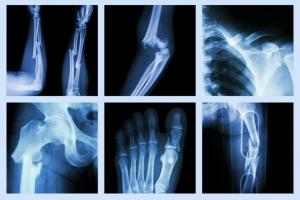The 5 differences between genotype and phenotype
Genetics explains all physiological phenomena of living beings, from the origin of life to radiation evolutionary evolution in specific parts of history, going through diseases, genetic conditions, facial features and many more things. Each of our cells has DNA inside it and, without it, cellular metabolism and existence itself would be impossible.
Although it may seem difficult to understand, the transformation of the instructions of the genome into proteins encodes our external traits. DNA, packaged in the form of chromosomes within the cell, contains a series of nucleotides of great interest, specifically in genes. These DNA sequences are "copied" (transcribed) into messenger RNA and this travels to the cytoplasm.
The messenger RNA is "read" (translated) by ribosomes, which assemble amino acids according to the order established by the genes, to give rise to the necessary proteins. Thus, the genome is transformed into living tissues.
With this express class of protein synthesis, we are prepared to show you
the differences between genotype and phenotype, which separates the genetic code from individual characteristics.- Related article: "Differences between DNA and RNA"
The Basics of Genetics
All human cells are derived from the division of a zygote, a cell resulting from the union of a female gamete (ovum) and a male gamete (sperm). Each gamete is haploid, which means that it has half the genetic information of what is expected. (n = 23) to, when joining with its partner, give rise to a functional diploid organism (2n = 46).
Our species is diploid and has 46 total chromosomes in the nucleus of each somatic cell, 23 from the mother and 23 from the father. Diploidy is a clear evolutionary adaptation, since by presenting “double” genetic information, we also have two copies of each gene. Each of the forms that a gene can acquire is known as an “allele”, differentiated from the rest by its sequence. So that, we inherit two alleles for each gene, one from the father and one from the mother.
What are the differences between genotype and phenotype?
This introduction was necessary, because from here on we are going to move into much more complex terrain of alleles, genes, characters and terms. Next, we show you the differences between genotype and phenotype.
1. The genotype is not seen externally, but the phenotype is
The genotype is the set of genetic information that a particular organism possesses in the form of DNA. This includes genes, extragenic regions, and sequences related to genes that do not code for proteins as such. In other words, the genotype is the set of nucleotides arranged in the form of the DNA double helix that differentiates us from other species and from other individuals of the same species.
On the other hand, the phenotype refers to the set of physical and behavioral traits that an individual exhibits based on their genotype (it is not an ethereal concept, but visible). In any case, in the subsequent sections we will see that the phenotype is not only the manifestation of the genotype, despite what is argued in general sources.

2. The phenotype is not just a product of the genotype
Mendel's laws and Mendelian genetics have been very helpful in paving the way for modern geneticists, but in many areas they fall short.. Let's take an example: a pea may have allele (a) that codes for rough skin, while allele (A) codes for smooth skin. The pea (aa) will be rough and the pea (AA) smooth, right?
So what happens if we put the pea (AA) under water for 3 hours a day and its surface ends up becoming rough from water stress? With this case, we want to exemplify that genotype alone does not explain phenotype, since the environment, nutrition and epigenetic mechanisms promote the appearance of variability beyond the alleles. A pea (AA) can have wrinkled skin from environmental stressors, not because its genome dictates.
The same premise holds when analyzing genetically identical people, such as twins (saving sporadic mutations). Although many inherited disorders occur in both at the same time (such as disorders of personality), other times one of the twins may have a psychiatric pathology and the other not. The same goes for weight, skin tone, muscles and many other things. If one leads a different lifestyle from the other and lives in a different region, he will naturally show a different genotype from his twin brother.
- You may be interested in: "The 6 parts of the chromosome: characteristics and functions"
3. A character is not always encoded by a single gene
Generally, an organism is said to be homozygous for a trait when both alleles (those on each parent's chromosome) are the same. In other words, if there is a possibility of inheriting a dominant allele (B) and a recessive allele (b), an individual can be homozygous dominant (BB), homozygous recessive (bb) or heterozygous (Bb). In the latter case, the allele that is expressed will be the dominant one (B).
In the most deterministic explanations of genetics, each pair of alleles (bb, BB, or Bb) will encode the nature of a particular trait, such as eye color. Even so, it is shocking to discover that an apparently simple character such as eye color is influenced by more than 3 genes: EYCL1, EYCL2, EYCL3 (more than 6 alleles).
Anyway, some diseases are monogenic, that is, they are explained by the dysfunction of one or both alleles within the same gene. Sickle cell anemia (mutations on chromosome 11), cystic fibrosis (mutations on chromosome 7) and hemochromatosis (mutations on chromosome 6) are some examples of diseases monogenic.
4. Genotype and phenotype don't always agree
If we continue with the train of thought from the previous example, we will discover that many inherited diseases are autosomal recessive, that is, if there is a non-mutated allele (D), the one that is dysfunctional (d) will remain masked. When a condition is recessive, it will only be expressed by the descendants (dd), while the (Dd) will be carriers or will show a much more attenuated signology.
For this reason we have said before that diploidy is an adaptive condition. When the gene on the chromosome of one parent (the mutated allele) fails, it is expected that the copy on the chromosome of the other will be able to fill the gap. In any case, there are some diseases that are dominant, and in them it is enough that one of the genes is mutated for the condition to manifest itself in its entirety.
5. Sometimes the phenotype is more than the sum of its parts
We have told you that a living being can be homozygous or heterozygous for a character. Heterozygotes always show the character encoded by the dominant allele (A), while the recessive (a) is masked. Anyway, as in everything in this life, there are exceptions that confirm the rule.
Sometimes alleles are codominant and are expressed at the same time, forming a character other than the sum of their parts. For example, if the gene for the color of the petals of a flower has a variability in the form of an allele white (w) and red allele (W), if both are codominant, the specimen (Ww) will have petals with white spots and red
Resume
As a small note, it should be noted that all the alleles that we have named have received an arbitrary name for the purpose purely informative, but do not correspond to an established and standardized genetic designation in all cases. What we want to show when using these symbols is that a recessive allele is represented with a lowercase letter and a dominant one with a capital letter, nothing more.
Beyond technicalities, it is necessary to emphasize that the phenotype is not always the exact manifestation of the genotype. The environment, nutrition, exercise and epigenetic mechanisms (activation or inhibition of genes to throughout life) also play an essential role in the variability of traits in the human population.

